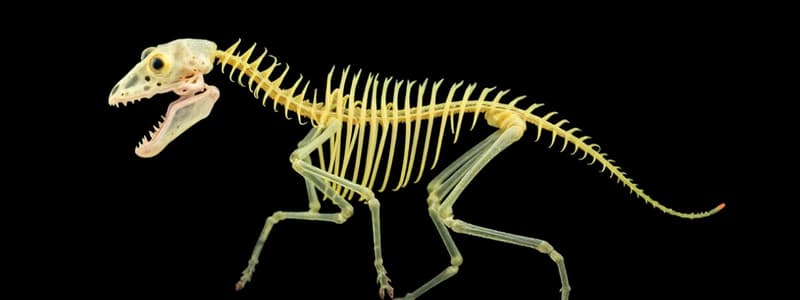Podcast
Questions and Answers
Which of the following is NOT one of the five unifying themes of biology?
Which of the following is NOT one of the five unifying themes of biology?
- Energy & Matter
- Information
- Imagination (correct)
- Organization
What results from the arrangement and interaction of parts within a system?
What results from the arrangement and interaction of parts within a system?
emergent properties
What name is given to the exploration of a biological system by analyzing the interactions among its parts?
What name is given to the exploration of a biological system by analyzing the interactions among its parts?
systems biology
A cell is the basic unit of all non-living things.
A cell is the basic unit of all non-living things.
What do genes encode information for?
What do genes encode information for?
What is genomics?
What is genomics?
What 'domain of life' do humans belong to?
What 'domain of life' do humans belong to?
What is the most common form of feedback regulation?
What is the most common form of feedback regulation?
What are the modified descendants of common ancestors?
What are the modified descendants of common ancestors?
What is taxonomy?
What is taxonomy?
Which of the following is NOT a member of the 'domain' Eukarya?
Which of the following is NOT a member of the 'domain' Eukarya?
The idea that the environment consistently selects for the propagation of beneficial traits among naturally occurring variant traits in the population is called what?
The idea that the environment consistently selects for the propagation of beneficial traits among naturally occurring variant traits in the population is called what?
What are the two cell types?
What are the two cell types?
Match each cell type with its description:
Match each cell type with its description:
What part of the eukaryotic cell helps with communication, transportation and protection?
What part of the eukaryotic cell helps with communication, transportation and protection?
What is the information central of the cell?
What is the information central of the cell?
What is protein synthase?
What is protein synthase?
The smooth endoplasmic reticulum has ribosomes.
The smooth endoplasmic reticulum has ribosomes.
What do golgi apparatus contain?
What do golgi apparatus contain?
What type of enzymes do lysosomes contains?
What type of enzymes do lysosomes contains?
Where does cellular respiration occur?
Where does cellular respiration occur?
What specialized metabolic compartments are bounded by a single membrane?
What specialized metabolic compartments are bounded by a single membrane?
Of what use are motor proteins to the cytoskeleton?
Of what use are motor proteins to the cytoskeleton?
Animals lack cell walls but what acts as their cell wall?
Animals lack cell walls but what acts as their cell wall?
Which junction type are pressed together to prevent leakage
Which junction type are pressed together to prevent leakage
What model states that a membrane is a fluid structure with a mosaic of various proteins embedded in it?
What model states that a membrane is a fluid structure with a mosaic of various proteins embedded in it?
Does passive transport needs ATP to work?
Does passive transport needs ATP to work?
What is the voltage difference across a membrane?
What is the voltage difference across a membrane?
The synthesis of RNA using information in DNA is called ______
The synthesis of RNA using information in DNA is called ______
What are ribosomes a site of?
What are ribosomes a site of?
Flashcards
Homeostasis
Homeostasis
The body's ability to maintain stable internal conditions despite external changes.
Negative Feedback
Negative Feedback
A regulation mechanism that counteracts a process to maintain homeostasis.
Positive Feedback
Positive Feedback
A process that amplifies or enhances a change or output in the body.
Cell
Cell
Signup and view all the flashcards
Gene Expression
Gene Expression
Signup and view all the flashcards
Chromosomes
Chromosomes
Signup and view all the flashcards
Metabolism
Metabolism
Signup and view all the flashcards
Anabolism
Anabolism
Signup and view all the flashcards
Catabolism
Catabolism
Signup and view all the flashcards
Natural Selection
Natural Selection
Signup and view all the flashcards
Taxonomy
Taxonomy
Signup and view all the flashcards
Eukaryotic Cells
Eukaryotic Cells
Signup and view all the flashcards
Prokaryotic Cells
Prokaryotic Cells
Signup and view all the flashcards
Ribosomes
Ribosomes
Signup and view all the flashcards
Endoplasmic Reticulum (ER)
Endoplasmic Reticulum (ER)
Signup and view all the flashcards
Golgi Apparatus
Golgi Apparatus
Signup and view all the flashcards
Mitochondria
Mitochondria
Signup and view all the flashcards
Nucleus
Nucleus
Signup and view all the flashcards
DNA Replication
DNA Replication
Signup and view all the flashcards
Transcription
Transcription
Signup and view all the flashcards
Translation
Translation
Signup and view all the flashcards
Mutation
Mutation
Signup and view all the flashcards
Homologous Chromosomes
Homologous Chromosomes
Signup and view all the flashcards
Meiosis
Meiosis
Signup and view all the flashcards
Mitosis
Mitosis
Signup and view all the flashcards
Alleles
Alleles
Signup and view all the flashcards
Phenotype
Phenotype
Signup and view all the flashcards
Genotype
Genotype
Signup and view all the flashcards
Genetic Drift
Genetic Drift
Signup and view all the flashcards
Homozygous
Homozygous
Signup and view all the flashcards
Heterozygous
Heterozygous
Signup and view all the flashcards
Study Notes
Five Unifying Themes of Biology
- Organization
- Information
- Energy and Matter
- Interaction
- Evolution
Emergent Properties
- Results from the arrangement and interaction of parts within a biological system
- Characterize non-biological entities as well (e.g., bicycle)
Systems Biology
- Explores biological systems by analyzing the interactions among its parts.
Cells
- Basic unit of an organism
- Lowest level that performs all life activities
- Enclosed by a membrane regulating material passage.
Feedback Regulation
- Output or product regulates process interactions.
- Negative feedback: Most common; response reduces initial stimulus (e.g., insulin signaling)
- Positive feedback: Output speeds up its own production (e.g., blood clotting)
Evolution
- Modern organisms descended from modified ancestors
Taxonomy
- Branch of biology naming and classifying species into broader groups.
Domains of Life
- Bacteria: Diverse and widespread, prokaryotes
- Archaea: Extremophiles (e.g., salty lakes, hot springs), prokaryotes
- Eukarya: All eukaryotes
- Plantae: Terrestrial multicellular eukaryotes
- Fungi: Nutritional mode of its members
- Animalia: Multicellular eukaryotes ingesting organisms
- Protista: Unicellular eukaryotes and some simple multicellular relatives
Genetics
- Chromosomes contain genetic material (DNA)
- Genes encode molecules built by cells
- Gene expression is the total process of information in a gene directing cellular product manufacture.
- Genomics: Large-scale analysis of DNA sequences
- Genomes: Complete genetic library of an organism
Bioinfromatics
- Uses computational tools to organize, store, and analyze large amounts of biological data.
Studying That Suits You
Use AI to generate personalized quizzes and flashcards to suit your learning preferences.




